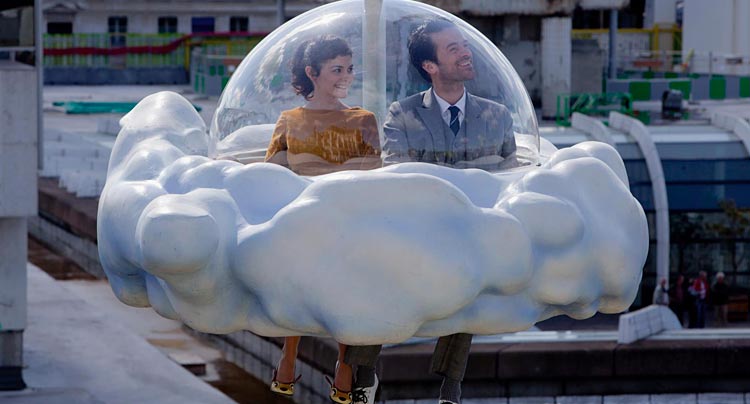
Breathtaking imagery and heaps of whimsical charm, but is often exhausting at the same time.

Breathtaking imagery and heaps of whimsical charm, but is often exhausting at the same time.
No filmmaker could pull off adapting Boris Vian’s “unfilmable” novel better than the inventive Michel Gondry. Before the opening titles finish Gondry demonstrates his trademark whimsy and wacky production style; a chef receives ingredients through a television set, sunlight creates guitar strings, an assembly line of people rapidly finishing sentences on typewriters passing by on conveyor belts, and a doorbell that turns into a spider-like creature. You’ll be in for a long film if the opening sequence doesn’t fascinate you. Mood Indigo is an ambitious visual feast with more flair than underlying substance, ultimately becoming overwhelming by the end.
Colin (Romain Duris) is a wealthy inventor who lives in an extravagant Parisian apartment with his chef/lawyer/mentor Nicolas (Omar Sy). He cheerfully shows off his latest invention called a pianocktail, a piano that translates musical notes into a different cocktail flavors. But Colin’s mood quickly changes upon realizing the one thing missing from his life is love. Suddenly he decides his solitude is absolutely dreadful and demands to fall in love. So he sets out to accomplish just that.
At a dinner party, Colin instantly falls in love with a “girl like a Duke Ellington tune” named Chloe, played by the dashing Audrey Tautou. After wooing her by dancing the biglemoi, a jazzy dance in which the dancer’s legs stretch to impossible proportions, Colin decides to take her hand in marriage. But shortly after they do, Chloe begins to have fainting spells caused by a flower growing inside her lungs.

The amount of creative visual flair found in Mood Indigo is second to none. Gondry creates a fantasy dream world where underground forests exist along with a pair of shoes that have a mind of their own and shadows that can chase after you. One of the most memorable scenes is when the couple happily float above Paris in a cloud ride operated by a large crane (a literal expression of the phrase ‘floating on a cloud’). Gondry also shows off his technical skills. In an impressive honeymoon sequence, he implements a split-screen to divide the same shot where it’s raining on one side and sunny on the other. The contrast between the weather signifies change as the second half of Mood Indigo gets a little dark. Well, dark for a Gondry film anyways. Gloom visually settles in when the color of everything fades to monochrome and walls literally shrink to close in on characters.
While it’s a pleasure to marvel at these visuals, they eventually grow tiresome by the end of the two-hour film (note: Gondry did re-edit the film for the US release which cuts out about 30 minutes). That’s because almost every scene has something animating, morphing, or twitching. It simply becomes overstimulating. Also, the stop-motion animation adds charm and visual flair but rarely offers meaningful substance to the scene.
The biggest issue with Mood Indigo is not being able to balance the wildly imaginative cinematography with meaningful storytelling. Sometimes the film is weird just to be weird—a feat that Gondry has mastered — resulting in more fluff than essential moments. It’s hard to put all the blame on Gondry (he did adapt the story from a highly experimental novel), but none of the emotional notes were felt between the two leads despite solid performances from both. Mood Indigo has breathtaking imagery and heaps of whimsical charm, but is often exhausting at the same time.